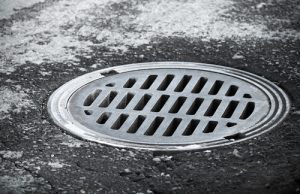Rats in Sewers!
By Chris Williams on August 12, 2011.
Q. I read a local news story that says we apparently have rats living in our sewer system and that they can get into homes by following pipes! Yikes! Please tell me that isn’t true!
A. Yes, I’m afraid it’s true and it’s a major issue complicating rat control. In many cities, rats use the older sewer systems as highways. Pest control professionals know that when they can’t get control of rats in a community, it’s often because the rats are being re-supplied by the sewer system as fast as they can be removed.
Sanitary sewers can supply all of a rat’s needs: warmth, protection, water, and food. Rats feed on floating or trapped food scraps or fecal material at the bottom or sides of pipes. They also feed on cockroaches that share the sewers with them. The introduction of garbage disposals some forty years ago no doubt increased the incidence of sewer rats as ground-up, undigested food is sent directly into their home. During cold winter months, sewer rats may stop all above-ground foraging, spending all of their time in the sewer system.
 Rats that live in sewers find breaks in drain pipes at faulty joints or where tree roots have invaded. They burrow through the ground coming up in yards or under sidewalks and then enter buildings. They can also follow lateral lines directly into buildings and then swim through floor drains. And yes, they have been known to swim through traps in toilets and enter buildings in that way. When construction or demolition projects reroute or upgrade sewer lines, the rats living inside the sewers can migrate into the construction area for as long as the sewer lines remain open.
Rats that live in sewers find breaks in drain pipes at faulty joints or where tree roots have invaded. They burrow through the ground coming up in yards or under sidewalks and then enter buildings. They can also follow lateral lines directly into buildings and then swim through floor drains. And yes, they have been known to swim through traps in toilets and enter buildings in that way. When construction or demolition projects reroute or upgrade sewer lines, the rats living inside the sewers can migrate into the construction area for as long as the sewer lines remain open.
Rats in sewers are usually brown rats, also called Norway rats, but in areas where there are no brown rats, the black, or roof, rat takes its place. Brown rats are semiaquatic by nature and frequently nest along the edges of streams, in marshy places, in rice fields, and near sewers. They can swim as far as half a mile in open water. They can dive and swim under water for 30 seconds at a time.
Sewer rats are more of a problem in older communities where storm and sanitary sewers are combined, where pipe is more than 30 years old, where street trees have invasive root systems (like elms or silver maples), and where old vaults or manholes are made of brick, which deteriorates and provides openings. Rats enter sewers at outlets and through manholes, catch basins, broken pipes, or drains near their nest sites. Black rats can even enter through sewer roof vent pipes.
Controlling rats in sewers can be a major undertaking often involving multiple city or county agencies, pest control contractors, and property owners. Often, control is met with little success due to the aging infrastructure of the sewer system. Baiting will harvest some rats, but it seems there are always more.
Stay up-to-date with Colonial Pest’s email newsletter!